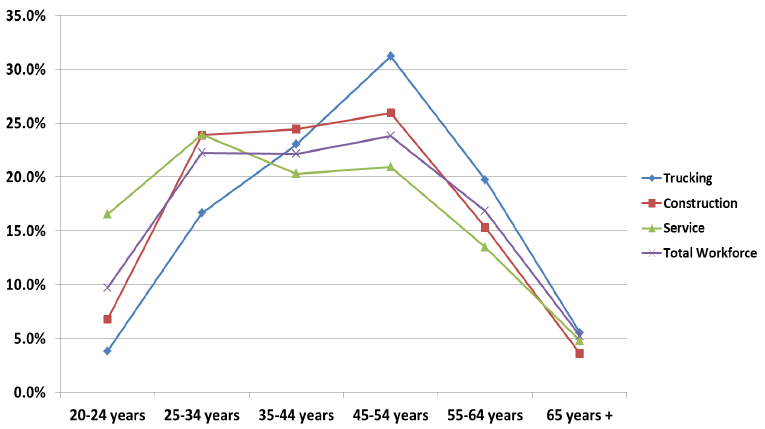
Top 5 Major Challenges Facing the Trucking Industry Today
The ATRI, headquartered in Arlington, Virginia, recently released their annual report outlining the most critical challenges facing the trucking industry in 2017. The report is based on survey responses from trucking industry stakeholders across the country, including both motor carriers and professional drivers.
We've compiled a summary of the top five major challenges.
1. Driver Shortage
This has been an industry concern for years, but it hasn't been at the top of the list since 2006. As the health of the U.S. economy improves, the demand for drivers has simultaneously increased. The problem, according to ATRI research, is that nearly 57 percent of the trucking workforce is at least 45 years old. If this trend continues, the American Trucking Associations estimates that the shortage will reach over 174,000 drivers by the year 2026. This chart, from ATRI, shows the low percentage of young truck drivers compared to other industries.
This chart, from ATRI, shows the low percentage of young truck drivers compared to other industries.2. ELD Mandate
Even after implementation, critics of the ELD mandate continue to have concerns. These include less independence, lower wages, and more impatient driving. Also, implementation of the mandate has been less than seamless, to say the least. Nearly twenty states have already delayed writing tickets for non-compliance. Another ten states are leaving ticket writing "up to the discretion of the individual officer." But still, a majority of ELD distaste seems to stem back to the lack of flexibility in Hours-of-Service rules.
3. Hours of Service
The ELD mandate more firmly enforces current Hours-of-Service rules. That's why flexible hours of service rules are now more important to drivers than ever before. Many industry stakeholders identified the sleeper berth provision as one that needs more flexibility. It currently requires drivers to take at least eight consecutive hours in their sleeper berth. Many believe this time should be split up throughout the day. Then drivers could rest when tired and readjust driving schedules to avoid major traffic congestion.
4. Truck Parking

Safe and available parking is an everyday necessity for truck drivers. While this ranks fourth among all respondents, it's the second most concerning challenge among drivers alone. Results of a 2016 ATRI study showed that 84 percent of drivers reported parking in unauthorized or undesignated parking at least once a week. The difficult choice many drivers face is whether to drive beyond what HOS rules allow, or to stop and park in an unauthorized or unsafe location.
5. Driver Retention
According to American Trucking Association's 2017 second-quarter report, the turnover rate for large truckload fleets reached 90 percent. Similarly, the turnover rate for smaller carriers hit 85 percent. Obviously, adding more drivers to the workforce only proves beneficial if those drivers stay. Driver turnover raises recruitment and training costs, which only makes it harder to attract the right drivers. Some motor carriers have been trying to combat these low retention numbers by using sign-on/stay-on bonuses.
More Critical Trucking Industry Challenges
The additional challenges outlined in the 2017 ATRI report include:- CSA
- Cumulative Economic Impact of Regulations
- Driver Distraction
- Transportation Infrastructure/Congestion/Funding
- Driver Health and Wellness.
